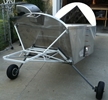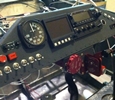


random user submitted photo
VW Questions
4 posts
• Page 1 of 1
VW Questions
Hi Guys,
I'm breaking in my VW engine (5 hours in) and have some questions concerning best practices, break in procedure, etc. for VW engines.
First, I know that temps are supposed to come down after break in.
Question: Just how much should the CHTs and Oil Temps come down as the engine breaks in?
I've been working to reduce CHTs. I'm down to 350 on the hottest and 300 on the coolest while in cruise with OAT of ~80 Deg. I'm tempted to keep at it until I can't figure out how to reduce them further. But..., I worry that the engine won't break in properly if CHTs are too low.
Question: Can CHTs be too low during engine break in? Can CHTs be too low after break in?
I'm a little concerned about the spread of CHTs. Since technically VWs only have two heads, what I'm seeing is a significant temperature gradient from end to end of the cylinder heads.
Question: Would it be better for the engine if CHTs were closer? Has anyone installed deflectors to block some of the air from the front cylinders similar to what Vans does on the RVs?
I'm sure I'll think of something else as soon as I hit the submit :-)
Thanks for Your Time,
Wes
I'm breaking in my VW engine (5 hours in) and have some questions concerning best practices, break in procedure, etc. for VW engines.
First, I know that temps are supposed to come down after break in.
Question: Just how much should the CHTs and Oil Temps come down as the engine breaks in?
I've been working to reduce CHTs. I'm down to 350 on the hottest and 300 on the coolest while in cruise with OAT of ~80 Deg. I'm tempted to keep at it until I can't figure out how to reduce them further. But..., I worry that the engine won't break in properly if CHTs are too low.
Question: Can CHTs be too low during engine break in? Can CHTs be too low after break in?
I'm a little concerned about the spread of CHTs. Since technically VWs only have two heads, what I'm seeing is a significant temperature gradient from end to end of the cylinder heads.
Question: Would it be better for the engine if CHTs were closer? Has anyone installed deflectors to block some of the air from the front cylinders similar to what Vans does on the RVs?
I'm sure I'll think of something else as soon as I hit the submit :-)
Thanks for Your Time,
Wes
Wes Ragle
Onex #89
Conventional Gear
Long Tips
Hummel 2400 w/Zenith Carb
Prince P Tip 54x50
First Flight 06/23/2020
42.8 Hrs. as of 10/30/21
Onex #89
Conventional Gear
Long Tips
Hummel 2400 w/Zenith Carb
Prince P Tip 54x50
First Flight 06/23/2020
42.8 Hrs. as of 10/30/21
- WesRagle
- Posts: 899
- Joined: Fri Jan 05, 2018 12:35 pm
- Location: Weatherford, Tx
Re: VW Questions
Wes,
In my opinion if you're generally around 350 or lower early in the program you're fine where you are. Temps will come down 30-50 deg as things break in, and you'll tweak the cooling little by little as well. You're in great shape, so keep at it.
Jeff
In my opinion if you're generally around 350 or lower early in the program you're fine where you are. Temps will come down 30-50 deg as things break in, and you'll tweak the cooling little by little as well. You're in great shape, so keep at it.
Jeff
- sonex1374
- Posts: 605
- Joined: Thu Mar 27, 2014 1:02 am
Re: VW Questions
Hi Wes,
I have the standard top mounted oil cooler om the Aerovee and had no problems with oil temps so far except for one day when OAT were above 104°F. I diverted and waited until the evening to continue the flight.
To have more evenly spread CHT's, I installed deflector plates on front cylinders, see pics. They reduced the spread to about 15°. What you see is a trial set-up, the final version is slightly higher and nicely finished!
I have the standard top mounted oil cooler om the Aerovee and had no problems with oil temps so far except for one day when OAT were above 104°F. I diverted and waited until the evening to continue the flight.
To have more evenly spread CHT's, I installed deflector plates on front cylinders, see pics. They reduced the spread to about 15°. What you see is a trial set-up, the final version is slightly higher and nicely finished!
- Attachments
-
- deflector.JPG (66.56 KiB) Viewed 2254 times
Dirk Verdonck
Leffinge, Belgium
Onex #117
Taildragger, Aerovee 2.1, MGL iEFIS, TRIG radio and Transponder, electric flaps, external elevator trim, shortened wingtips, hydraulic brakes, hightened seat pan, extra inspection panels, etc
Leffinge, Belgium
Onex #117
Taildragger, Aerovee 2.1, MGL iEFIS, TRIG radio and Transponder, electric flaps, external elevator trim, shortened wingtips, hydraulic brakes, hightened seat pan, extra inspection panels, etc
- dirkverdonck
- Posts: 88
- Joined: Sun Sep 21, 2014 9:01 am
- Location: Leffinge, Belgium
Re: VW Questions
Hi Jeff,
I'll keep at cooling a bit longer. I listened to Episode 4 - "Engine Cooling" Podcast again and think I can do a little better on the cowl exit. It is rather cluttered at the exit. With the oil temp under control I can run the manometer tubes through the cabin heat flapper, tape it up and get a reading on pressure drop across the baffling. I think after taking some readings I'll cut the tube to the high pressure side of the baffling and get some readings of the differential pressure between the lower cowl and the cockpit. If the cockpit is at a higher pressure than the low pressure side of the baffling I won't be as worried about CO in the cockpit. We'll see.
I'm also giving that sharp lip on the upper cowl the hairy eye. It would be nice if I could smooth the air flow to the rear cylinders and get a drop in rear cylinder temps before trying to balance temps front to rear.
Hi Dirk,
Cool. Once I've done all I can do to bring the temps down I'll try the deflectors to balance front to rear temps.
As far as the oil cooler is concerned, the game I'm playing is to get the oil temperature where I want it with minimum air flow. A high quality heat exchanger with the minimum airflow needed to keep oil temps down should give me maximum temp at the cooler exit. That should give me the option of a toasty cockpit in the Winter months.
Wes
sonex1374 wrote:In my opinion if you're generally around 350 or lower early in the program you're fine where you are. Temps will come down 30-50 deg as things break in, and you'll tweak the cooling little by little as well. You're in great shape, so keep at it.
I'll keep at cooling a bit longer. I listened to Episode 4 - "Engine Cooling" Podcast again and think I can do a little better on the cowl exit. It is rather cluttered at the exit. With the oil temp under control I can run the manometer tubes through the cabin heat flapper, tape it up and get a reading on pressure drop across the baffling. I think after taking some readings I'll cut the tube to the high pressure side of the baffling and get some readings of the differential pressure between the lower cowl and the cockpit. If the cockpit is at a higher pressure than the low pressure side of the baffling I won't be as worried about CO in the cockpit. We'll see.
I'm also giving that sharp lip on the upper cowl the hairy eye. It would be nice if I could smooth the air flow to the rear cylinders and get a drop in rear cylinder temps before trying to balance temps front to rear.
Hi Dirk,
dirkverdonck wrote:I have the standard top mounted oil cooler om the Aerovee and had no problems with oil temps so far except for one day when OAT were above 104°F. I diverted and waited until the evening to continue the flight.
To have more evenly spread CHT's, I installed deflector plates on front cylinders, see pics. They reduced the spread to about 15°.
Cool. Once I've done all I can do to bring the temps down I'll try the deflectors to balance front to rear temps.
As far as the oil cooler is concerned, the game I'm playing is to get the oil temperature where I want it with minimum air flow. A high quality heat exchanger with the minimum airflow needed to keep oil temps down should give me maximum temp at the cooler exit. That should give me the option of a toasty cockpit in the Winter months.
Wes
Wes Ragle
Onex #89
Conventional Gear
Long Tips
Hummel 2400 w/Zenith Carb
Prince P Tip 54x50
First Flight 06/23/2020
42.8 Hrs. as of 10/30/21
Onex #89
Conventional Gear
Long Tips
Hummel 2400 w/Zenith Carb
Prince P Tip 54x50
First Flight 06/23/2020
42.8 Hrs. as of 10/30/21
- WesRagle
- Posts: 899
- Joined: Fri Jan 05, 2018 12:35 pm
- Location: Weatherford, Tx
4 posts
• Page 1 of 1
Who is online
Users browsing this forum: No registered users and 14 guests







